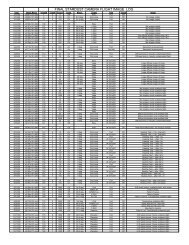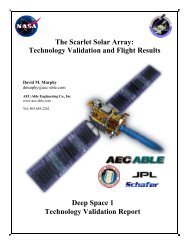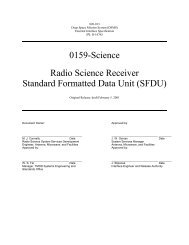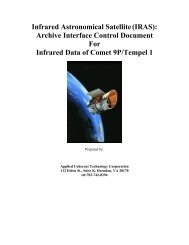MISSION PLAN - PDS Small Bodies Node
MISSION PLAN - PDS Small Bodies Node
MISSION PLAN - PDS Small Bodies Node
Create successful ePaper yourself
Turn your PDF publications into a flip-book with our unique Google optimized e-Paper software.
4.2.4 Mission Operations Considerations<br />
Current mission operations plan to issue a minimum of weekly updates to the spacecraft<br />
attitude and aerogel grid collector angle during ISP collection, and spacecraft attitude<br />
during the CIDA experiment. An intentional lead-lag strategy should be established for<br />
most efficient tracking of the ISP stream. However, the final spacecraft attitude and<br />
collector angle update schedules can be established only after the post launch final uplink<br />
schedule is known. JPL will provide a list of daily spacecraft attitudes and collector<br />
angles (see section 12) from which LMA will build the required lead-lag update<br />
schedule.<br />
4.3 Mission Operations<br />
Mission operations during the Cruise phases are summarized in Tables 4.3-1.a-c. The<br />
operations during these phases drop to the lowest level of the mission. Activities<br />
required are essentially to maintain the spacecraft attitude profile to ensure adequate<br />
reception of solar power, communication with Earth at the scheduled times and tracking<br />
of ISP’s during the collection and CIDA periods. In addition, the spacecraft gathers and<br />
transmits information on spacecraft health as well as the sporadic science data. Imaging<br />
plans during cruise are limited to calibrations and standard camera maintenance. These<br />
plans are described in Table 4.3-2.<br />
Primary activities on the ground are spacecraft subsystem analysis and maintenance, and<br />
the generation of uplink commands. DSN tracking continues using the 34-m HEF<br />
network. Medium Gain Antenna (MGA) tracking is performed to obtain radiometric data<br />
for orbit determination and DSM/TCM formulation. This radiometric data is comprised<br />
of both ranging data and two-way Doppler data (See the Navigation Plan for more<br />
details). Spacecraft mode tracking is performed for telemetry and command. An uplink<br />
frequency of once per month is anticipated, however, commanding will increase during<br />
ISP collection and CIDA periods to allow tracking of the reference particle.<br />
The current request for DSN tracking in support of DSM-1 and its cleanup maneuver,<br />
TCM-3, is reduced from the baseline for TCMs. The power constraint to avoid casting<br />
shadows on the solar arrays with the whipple shields, and sun-Earth geometry during this<br />
phase of the mission would drive a need for large yaw slews (rotation about the z-axis),<br />
160° over 4 hrs, between the ISP collection attitude and the MGA communications<br />
attitude. Given this slew scenario, the daily communication requirement surrounding<br />
TCMs reduces the amount of time available for ISP collection. Two action are taken to<br />
reduce the impact of NAV tracking on spacecraft slewing and on ISP collection time.<br />
The first is to schedule use of the HGA instead of the MGA. The HGA’s tighter<br />
deadband, together with small SPE angles (also coincident with this phase of the<br />
mission), allows the spacecraft to communicate with the Earth without performing a large<br />
61






